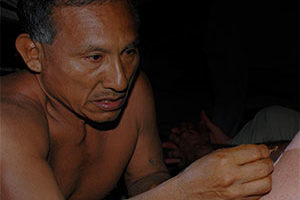 The Encyclopedia is written by and from the worldview of the Matsés shaman, describing how rainforest animals are involved in the natural history of the plants and connected with diseases. It is a true shamanic encyclopedia, fully written and edited by indigenous shamans, the first of its kind and scope.©Acaté
The Encyclopedia is written by and from the worldview of the Matsés shaman, describing how rainforest animals are involved in the natural history of the plants and connected with diseases. It is a true shamanic encyclopedia, fully written and edited by indigenous shamans, the first of its kind and scope.©Acaté The erosion of traditional medicine and culture has imparted a devastating effect on the self-sufficiency and health of indigenous peoples worldwide. The acculturation of Amazonian peoples has been, at best, a difficult transition. Most tribes usually suffer a profound loss of cultural identity and social cohesion, if not extinction. Traditional knowledge and beliefs are no longer valued and passed down to younger generations. As a result, much of the wisdom of the elders, including the healing knowledge of the shamans, is being irreplaceably lost at a rapid pace. Lacking their own systems of healing, these tribes become totally dependent on the rudimentary external health care available in remote and low external resource settings. It is no coincidence that, in every country of South America, indigenous peoples have the highest rates of disease and mortality.
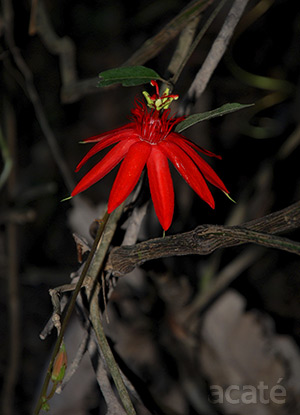
Passiflora sp. ©Acaté
Before the start of Acaté’s Traditional Medicine Initiative in 2013, the Matsés rich and ancestral legacy of healing knowledge and wisdom was on the precipice of being lost forever.
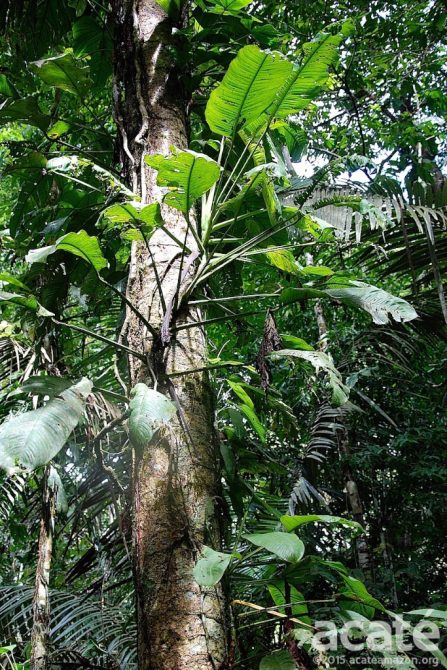
The Amazon is the greatest repository of botanical diversity in the world©Acaté
Their wealth of knowledge and techniques of treatment had been passed on through oral tradition for millennia. This knowledge is more than a method to thrive in one of the most biodiverse yet difficult ecosystems on the planet, it is a realization of their deep spiritual and physical ties to the natural world. Throughout the world so much traditional knowledge was lost during the fallout from European conquest and disease. Today, with cultural change encroaching upon and destabilizing even the most isolated societies, this knowledge is disappearing ever more rapidly.
For the Matsés, peaceful outside contact was initiated in 1969, after decades of conflict. By then, the current elder healers had already mastered their knowledge before being told it was useless by missionaries. Today’s young Matses still encounter discrimination when dealing with the outside world. This has led many young Matsés to lose interest in or even feel ashamed of their culture. As a result of these influences, when we started the medicine project not a single elder had an apprentice. Yet at the same time, most villages still actively depended on and utilized the medicinal plant knowledge of the few remaining aging healers as a primary source of health care.
Once extinguished, this knowledge, along with the tribe’s self-sufficiency, can never fully be reclaimed. Historically, what has followed the loss of endemic health systems in many indigenous groups is near total dependency on the rudimentary and extremely limited external health care that is available in such remote and difficult-to-access locations. Not surprisingly, in most countries, indigenous groups have the highest rates of mortality and disease.
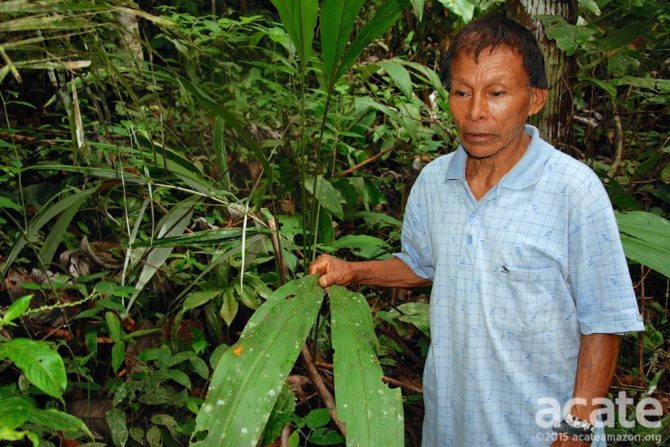
At the start of Acaté’s initiative, not a single Matsés elder plant master had an apprentice©Acaté
The Matsés elders who valued, guarded, and were ready to pass on their knowledge were aware it was perilously close to being lost. They had witnessed neighboring indigenous groups lose their traditions. From the outset, the Matsés elders and Acaté developed a plan of action to ensure their traditional system of health would endure for future generations as they adapt to the outside world. The first phase involved creation of a written encyclopedia of their traditional medicine knowledge. Each chapter of this traditional medicine encyclopedia was to be written by an elder shaman, chosen by the community. The elder was paired with a younger Matsés who over months transcribed his knowledge in writing and photographed each plant. The photos and text were then to be compiled and typed up on a laptop by a third Matsés who is an expert in a written transcription of their language. The written form of the Matsés language was articulated after contact with missionaries, who were intent on producing a Matsés version of the Bible. The younger Matsés were taught to read and write their language by missionaries who eventually produced a bible. This bible was the only Matsés language book at the time of its publication. The Matsés would now use these skills to document their own ancestral knowledge!
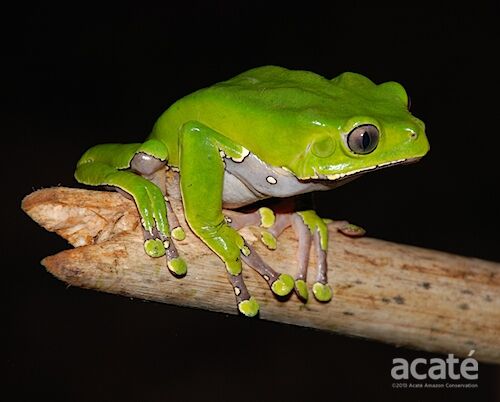
The skin secretions of the giant monkey tree frog (Phyllomedusa bicolor) are used in hunting rituals by the Matsés. After reports of the Matsés use of it emerged from the forest, laboratory investigations of samples of the frog’s secretions taken from Matsés territory revealed a complex cocktail of peptides with bioactive properties. Over 70 patents to date have been filed for applications on peptides derived from the frog’s secretions, without recognition of indigenous peoples for which it has long held a unique and important role in their culture.©Acaté
This novel approach would prove significant as an innovative mechanism to protect their knowledge from theft by the outside world. History is replete with examples of theft from indigenous peoples. For the Matsés, the threat is all too real as their knowledge has been stolen and misappropriated in the past.
For decades, prior efforts by conservation groups to protect against loss of indigenous medicinal plant knowledge were stifled by concerns of facilitating biopiracy. With the medicinal plant knowledge disappearing fast among most indigenous groups and no one to write it down, the true losers in the end are tragically the indigenous stakeholders themselves. The methodology developed by the Matsés and Acaté is a template for other indigenous cultures to safeguard their ancestral knowledge.
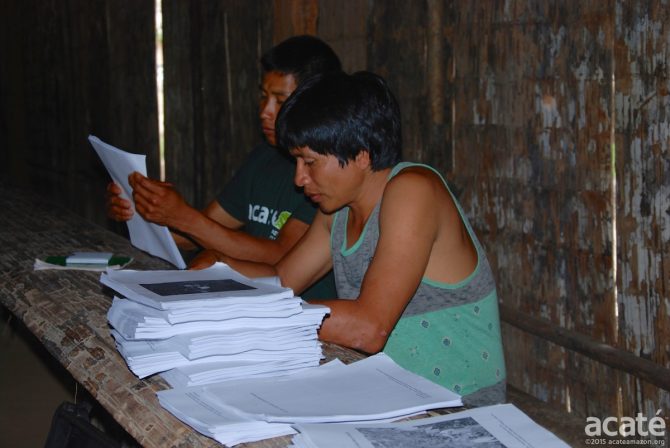
Wilmer López, a Matsés who has an expert at their written language, reviewing early chapter drafts©Acaté
After two years of diligent work, in May 2015, the first volume of the encyclopedia was finalized during a historic meeting of the remaining Matsés elder shamans in the Matsés village of Puerto Alegre on the upper Yaquerana River.
The production of the first indigenous medicine encyclopedia received worldwide social media attention and inspired other indigenous groups and conservation organizations to begin similar projects. Without public announcement and fanfare, the Matsés leaders, elders and communities set-out quietly to continue their work in the creation of a second volume comprising an additional five chapters. Their work was carried out over two years with the support of Acaté and culminated in September 2017 with the completion of Volume II.
Phase II Revitalization through Healing Forests
The Encyclopedia is a historical and critical first step towards mitigating the existential threats to Matsés healing wisdom and self-sufficiency in health. The Encyclopedia alone, however, is not sufficient to maintain their self-sufficiency. Just as studying a western medical textbook does not make one a doctor, learning the Matsés traditional medicinal system takes much more than book study. Indigenous healing systems, like all healing systems, are based on experience that can only be transmitted through long apprenticeships. This was true when the current elders learned from their fathers and grandfathers before them.
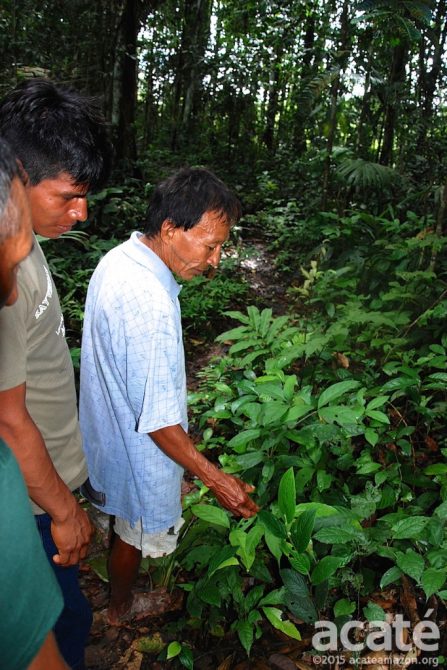
The framework of Phase II of the Traditional Medicine Initiative involves the creation of Healing Forest Medicinal Plant Gardens, based on traditional Matsés agroforestry. In the earlier Apprentices Program, elder shamans—who were also Encyclopedia chapter authors—were accompanied in the forest by younger Matsés to learn the plants and assist in treating patients. The Matsés elders and Acaté decided to merge the pilot Apprentices program with the Healing Forest Medicinal Plant Gardens project that is based on traditional Matsés agroforestry.
For many, the term ‘medicinal garden’ might connote a sun-exposed garden adjacent to house or a farm clearing. What the Matsés are doing is different. Many of the rainforest vines, tree saplings, ferns and fungi that the Matsés use daily for healing will not grow in sun-exposed gardens. They require rainforest ecosystems for their propagation, adding considerable levels of complexity and challenge. Successfully transplanting and establishing these plants in the rainforests is not easy and requires a master’s understanding for successful cultivation. Western agroforestry and science could learn much from the innovation and mastery of these indigenous horticulturalists!
To an outsider, this forest might appear to be a nondescript stretch of rainforest along a footpath to their farms. In the presence of a master shaman pointing out the medicinal plants, you realize in a moment that you are surrounded in fact by a constellation of hundreds of medicinal plants cultivated by the Matsés healers for use in treatment of a diverse range of ailments. Healing plants are such abundance that truly careful attention must be made at all times to avoid clumsily stepping on a group of seedlings or small sapling.
It is important to also understand that the Healing Forests are not a new introduction but a restoration of traditional Matsés agroforestry practices that fell into abandon following sustained contact with the outside world. For generations, Healing Forests supplied the Matsés communities with an abundance of sustainably sourced medicinal plants to treat urgent health needs. The benefit of having the plants nearby, especially the rare ones, provides both a classroom for teaching and access for treating patients. These factors made the decision to re-establish Healing Forests an easy one.
The creation of a Healing Forest agroforestry plot in a community is a big production, taking over a month of full time work by an entire team. The teams creating each Healing Forest comprise one elder shaman, at least 6 apprentices, and one Matsés coordinator, usually an experienced apprentice. The design for each Healing Forest agroforestry area is individualized by each healer and community. Some prefer to place the plants along winding paths in the forest while others favor a more centralized design.
After the success of the first two Healing Forests in Buen Peru and Remoyacu, in May 2016, Matsés High Chief Wilder Flores proclaimed his intent to see Healing Forests restored in all 14 Matsés villages during his tenure of leadership.
Acaté seeks to maintain self-sufficiency of health care through the promotion of traditional systems of medicine. We provide programmatic support for elder tribal shamans to teach and impart the knowledge of the rainforest to younger generations of Matsés as well as to document and preserve, in their own language, their use of medicinal plants for the benefit of future generations. The communities have expressed interest in projects that include the integration of traditional medical practices (i.e. local herbal remedies), based on a successful and replicable model developed and implemented by project team members in other Amazonian communities.
The Matsés elders and apprentices alike confirmed that actually working with the plants in developing the medicinal Healing Forests was the most efficient way to teach the identifications and learn the applications. It also came up repeatedly in our discussions that consulting the Encyclopedia is a vitally important means of reinforcing field instruction from the shamans. Not all of the young participants in the Healing Forest program can be expected to acquire the knowledge to assume the mantle of a master shaman. Just like in Western societies, not everyone goes to medical school and becomes a physician. From those apprentices drawn out in each community, it provides the opportunity for the most dedicated and knowledgeable to emerge and select themselves out through their demonstrated aptitude, interest and dedication. The third phase set-out by Matsés elders is to identify the most knowledgeable and promising of the young apprentices and provide for further in-depth advanced apprenticeships with the remaining elder plant masters across their territory.
One such advanced apprentice we wrote about last year in our June 2016 field report is Mariano Lopez Rengifo, from the village of Buen Peru. As we noted earlier, the Matsés decided to prioritize and send shamans to create Healing Forests in communities that no longer had living shamans in residence. Buen Peru in one such village selected for this reason to receive training from Master Healer Alberto Bai of Puerto Alegre, a distant village on the Upper Yaquerana. Mariano was one of the six young Matsés men and women chosen by the community of Buen Peru to participate as an apprentice in creating the Healing Forest. In our tour of the agroforestry sites with Acaté leadership, visiting shamans and leaders, Mariano stood out from all apprentices and amazed all in attendance with his exceptional knowledge of plants. We were so intrigued we sat down with him to hear his story. Mariano told us that before studying with Maestro Alberto, he knew only of two plants, one of which was used to treat dogs. He said that his apprenticeship with Alberto was an awakening. He indicated would like to continue learning from Master Alberto, saying to us:
“It takes time to become a shaman. Just as you (Dr. Chris) spent years in school learning to use pharmaceuticals, my university is the jungle.”
Over the past year, Acaté provided support for Mariano to travel to Puerto Alegre. There he spent two months in residence under the tutelage of Master Alberto Bai. He also helped oversee the creation of the Healing Forest in that village. In addition to using both volumes of the Encyclopedia, Mariano has created his own notebook where he records his notes from the teachings of the elder plant masters. After further training with Alberto Bai and other remaining elders, he hopes to return to his village of Buen Peru to become the resident healer, filling a long void.
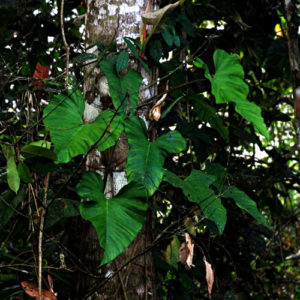
Philodendron sp. ©Acaté
BIOPROSPECTING STATEMENT: Note that the aforementioned activities will NOT include ethnobotanical collection of plant or biological specimens for collection outside of communities, public dissemination of medicinal species botanical identity, or commercial use of traditional knowledge. Acaté does not engage in bioprospecting, nor is it our policy to use any of the information obtained by the project goals for commercial purposes or for any terms beyond those described.
